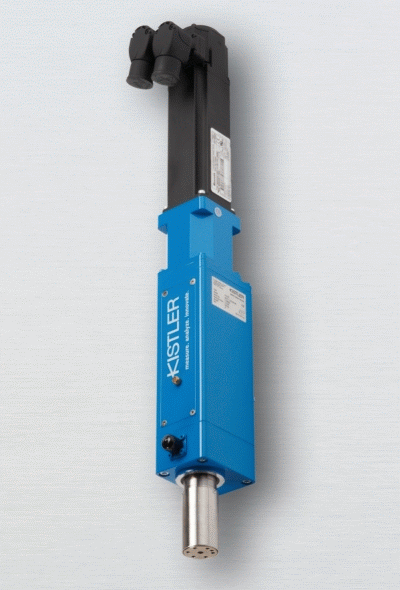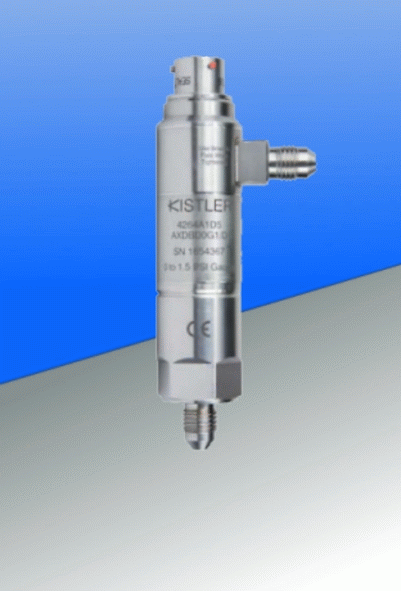 New servo press module has wireless telemetry for use in clean rooms
New servo press module has wireless telemetry for use in clean rooms
Suitability for use in cleanrooms to ISO 8 and wireless telemetry of the force signal are just two of the outstanding attributes of the new Type 2157B NCFT electromechanical, servo press module. These new features make the new module particularly suitable for use in processes with small test and joining forces, such as sensitive press-fit operations and test routines in the medical and precision product sectors.
The compact mechanism, integral piezoelectric force monitoring in the ram and two predefined measuring ranges from 0.05 kN to 1.5 kN make the new modules ideal for use in assembly and joining processes monitored by force-vs-displacement. Advantages include easy selection of the ideal measuring range, a high overload factor and modest user spare parts inventory. Complex drive profiles with a maximum speed of 400 mm/s and displacement repeatability of 0,002 mm can be achieved.
The new NC servo press module provides ultra-high precision measurement of extremely small forces directly on the tool holder under actual process conditions, without the need to mount a sensor on the ram. This eliminates any possibility of the measurement signal being impaired by dynamic characteristics of masses or moving cables.
Many medical consumables are required to be manufactured under cleanroom conditions. The NC joining module Type 2157B meets stringent, cleanroom production environment requirements defined by ISO 8 cleanrooms as standard and ISO 7 conditions can be met with minor adaptation.
 The new NCFT augments the range of NC servo press systems from Kistler. Five series now provide seamless coverage of measuring ranges from 0,05 to 600 kN. They are available not only as a system subassembly but also as complete manual workstations for development, prototyping or small-batch production.
The new NCFT augments the range of NC servo press systems from Kistler. Five series now provide seamless coverage of measuring ranges from 0,05 to 600 kN. They are available not only as a system subassembly but also as complete manual workstations for development, prototyping or small-batch production.
New Differential Pressure Sensors
Kistler Instruments has launched a range of small, versatile, high performance differential pressure sensor for use in harsh test environments where temperature extremes, high vibration and shock levels are present.
The design of the Type 4264A sensor is based upon proven Kistler piezoresistive sensing technology. A silicon sensing element is mounted within a high integrity seal assembly that is fully isolated from the pressure media by a welded 316L stainless steel or Hastelloy™ diaphragm. Integrated surface mount electronics condition the output from the silicon sensing element and provide temperature compensation. Additional electronic circuit boards can be added to configure the electrical output for a wide choice of voltage and mA outputs. As a result, the sensor can be factory configured to provide an electrical output to suit a variety of data acquisition systems. Additionally, non-interactive zero and span calibration adjustments can be provided. The silicon sensing element exhibits high performance for stability and repeatability, extremely important parameters for test applications.
The pressure sensing assembly features a unique, patented sealing method that enables the sensor to withstand multiple cycles without fatigue, a quality that is especially useful in cyclic applications. This design also enables flexibility in choice of pressure connections without the use of adaptors or ‘O’ rings.
The new sensors are available in both uni-directional and bi-directional types with pressure ranges from 0.1 to 10 bar differential, all with 300% proof pressure. ATAX versions are available for use in hazardous areas. Accuracy of 0.05% full scale (FS) and stability of 0.1% of FS per year combined with a wide temperature compensated range of -40 to +125o C make the new sensors ideal for R&D and product testing applications in automotive, aerospace and manufacturing industries especially engine and power train oil and coolant filter pressure monitoring and leak testing.
 Kistler modular test stand system
Kistler modular test stand system
Kistler has launched a modular test stand system designed for testing electric motors and gearing in the research and development laboratory, at production end of line and for quality assurance analysis. The test stands can incorporate a wide range of torque and speed sensors with manual or computer control. The computer controlled test stands can be equipped with an integrated power analyser with up to 12 voltage and 12 current measurement channels to provide separate efficiency specification for the motor and converter.
The load on the motor under test is provided by an active brake working in four quadrants. Sensors to measure torque from 0.01 to 25,000 Nm, power from 2 W to 500 kW and speed up to 120,000 rpm may be combined with a wide range of mechanical components, power analyser for data logging, signal conditioning and data interface to produce a test stand to meet the most demanding specification. Standard and customised software packages may be specified.
The modular design concept allows a test stand to be supplied quickly and cost effectively to meet any specification using well proven sub-systems.
 KiTorq Intelligent Torque Measuring Flange
KiTorq Intelligent Torque Measuring Flange
The Kistler KiTorq torque measuring flange system operates without an antenna ring and has standard flange geometry conforming to ISO7646 for easy installation. The open stator design allows faster installation whilst minimising the risk of damage and easier visual inspection during testing. The universal, intelligent stator may be used with any KiTorq rotor of the same speed rating for greater operational flexibility.
A choice of 500, 1,000, 2,000 or 3,000 Nm measuring ranges is available each with an accuracy class of 0.05% of range. The system has an excellent torque signal bandwidth of up to 10 kHz and a 60 pulses per revolution speed output.
A single, intelligent stator can be used with any KiTorq rotor of the same speed rating and will automatically recognise the rotor measuring range. This minimises hardware investment as one stator may be used with rotors of differing ranges for different applications. Installation is simplified by the contactless, digital telemetry that does not require an antenna ring.

